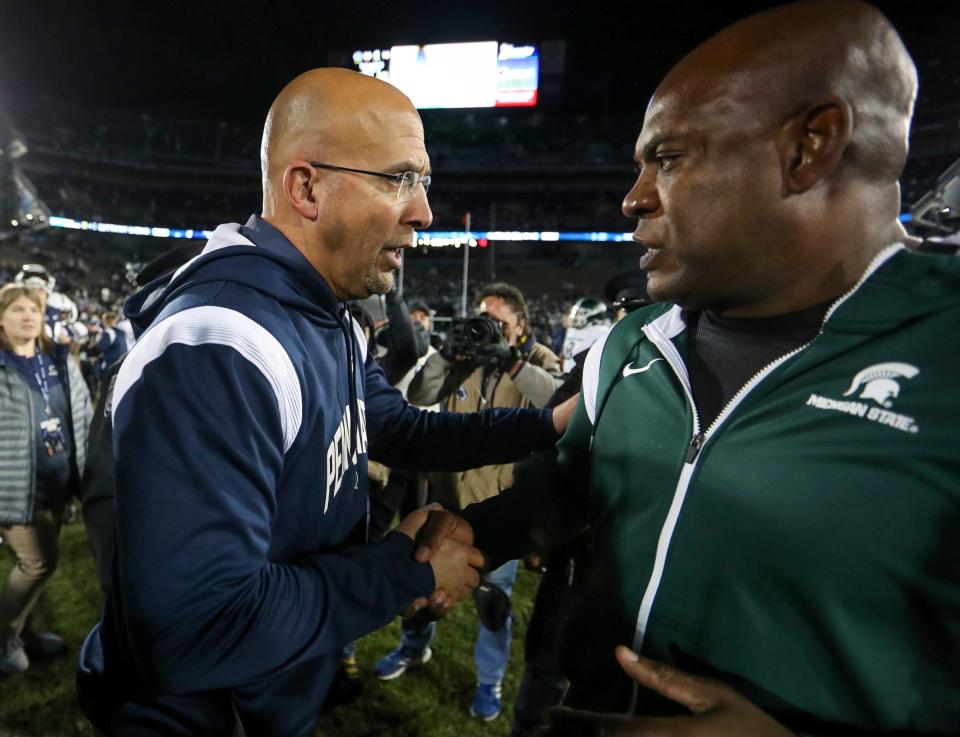Couch: Big Ten football is about to change and that could be good for Michigan State
INDIANAPOLIS – I don’t know how different Big Ten football is going to feel beginning in 2024, minus divisions, with USC and UCLA in the fold, with an expanded College Football Playoff at the end of the runway. Or how beneficial this new structure will be for Michigan State moving forward.
This season, though, without question, is the end of an era — for the Big Ten, for a team like MSU, battling in the East Division, and for the playoff, which after years of needless angst created by whoever came up with the four-team idea, mercifully increases to 12.
As MSU’s program tries to make its way back to contention, the end of the Big Ten divisions and the expansion of the playoff — both coming in 2024 — are potentially significant boons to the Spartans. And coincide with when expectations ought to rise for Mel Tucker’s program.
Tucker, understandably, isn’t sad about losing the East Division, with Ohio State, Michigan and Penn State, a trio that this season might make the East the toughest division in college football.
“I’m not going to be a sentimental guy in that regard,” MSU’s head coach said last week at Big Ten media days. “We're still going to have a tough schedule. But I'm not going to be wishing that we could go back to that.”
MSU doesn’t actually escape the East Division until a year after it’s gone. In 2024, the Spartans’ nine-game Big Ten slate just happens to feature all six of its East brethren, even if no longer tied together by a division, and doesn’t consist of either of the California schools.
But in 2025, that all changes. MSU’s regular-season schedule, for the first time since 2013, doesn’t include its nemesis, Ohio State. The only East Division schools on the docket that season are protected rival Michigan and Penn State, both at Spartan Stadium, and Indiana on the road. The schedule could still be a bear — with UCLA visiting and games at USC, Wisconsin, Iowa and Minnesota. But MSU will at least be judged in the same standings as the Hawkeyes, Badgers and Gophers.
Eventually, if Tucker’s tenure is living up to its promises, MSU should be competitive with Ohio State. But the Spartans won’t always have to beat the Buckeyes to win a Big Ten title or contend for a playoff berth.

After this season, MSU will begin to play every Big Ten team over a two-year period and, other than Michigan every year, only play two teams at a time in back to back years. In 2024 and 2025, those “two-play” teams for the Spartans are Penn State and Indiana. After 2025, the Nittany Lions and Hoosiers will fall into the every-other-year rotation and two more schools will take their place.
It’s as equitable as possible and, for an oversized league with 16 teams, allows for some sense of community. Never in this setup will MSU go seven years without a trip to Madison or Iowa City, which happened when they were in separate divisions.
It’s not that MSU, at its best, couldn’t be an every-year factor in the East. We saw that from the Spartans in the middle of the last decade. And since the division’s inception in 2014, MSU is 5-4 against both Michigan and Penn State. Ohio State in recent years has been a different kind of problem as MSU has faded from its heyday. The Spartans have lost seven straight against the Buckeyes and haven’t been remotely competitive against them since the second quarter in 2019.
Ohio State — as well as Michigan and Penn State — will still be in MSU’s way, but there’s so much more variance, so many more possibilities for the standings and how a season unfolds. And, most importantly, so much more room in the playoff.
If the 12-team playoff had existed since the four-team playoff began in 2014, the Big Ten would have averaged 2.8 teams per season, based on the final College Football Playoff rankings and the criteria for the new playoff. In six of nine years, the Big Ten would have had at least three teams in the field. Three times that would have included MSU (2014, 2015 and 2021). The path is so much more reasonable. Now it’s up to MSU to bring itself to that level consistently. That’ll be the expectation of Mel Tucker and Co. soon enough.
If you’re looking for a target date for when it's fair to insist MSU to be in the playoff conversation annually and compete with the top of the Big Ten most seasons … it’s 2025, which is also perfectly in line with when Ohio State falls off the schedule.
Tucker’s first real recruiting class — the 2022 group (after the Zoom COVID class of 2021) — will be seniors and redshirt juniors during that 2025 season. It’s the equivalent of expecting a big step forward from Mark Dantonio’s program in 2010, which occurred.
It’s fair to expect signs of growth before then, to expect coaching competence, to hope for exciting moments and upsets and, at some point in the next two years, to think MSU should begin to look like it belongs on the same field as Ohio State.
No one is suggesting that fans or the program sit around and wait for Tucker’s top recruits to mature and permeate the roster. But when they do, MSU’s program will be running a somewhat different race than it has been for the past decade.
RELATED: Couch: 3 quick takes on Michigan State football and Mel Tucker from Big Ten media days
Contact Graham Couch at gcouch@lsj.com. Follow him on Twitter @Graham_Couch.
This article originally appeared on Lansing State Journal: MSU football could be helped by a changing Big Ten, expanding playoff

